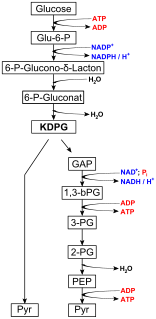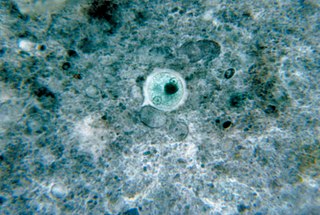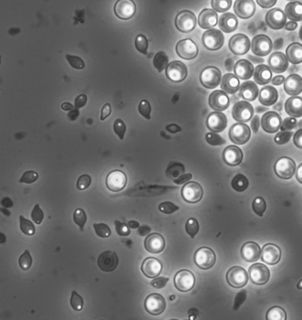Related Research Articles

Bacillus is a genus of Gram-positive, rod-shaped bacteria, a member of the phylum Firmicutes, with 266 named species. The term is also used to describe the shape (rod) of certain bacteria; and the plural Bacilli is the name of the class of bacteria to which this genus belongs. Bacillus species can be either obligate aerobes: oxygen dependent; or facultative anaerobes: having the ability to continue living in the absence of oxygen. Cultured Bacillus species test positive for the enzyme catalase if oxygen has been used or is present.

An endospore is a dormant, tough, and non-reproductive structure produced by some bacteria in the phylum Firmicutes. The name "endospore" is suggestive of a spore or seed-like form, but it is not a true spore. It is a stripped-down, dormant form to which the bacterium can reduce itself. Endospore formation is usually triggered by a lack of nutrients, and usually occurs in gram-positive bacteria. In endospore formation, the bacterium divides within its cell wall, and one side then engulfs the other. Endospores enable bacteria to lie dormant for extended periods, even centuries. There are many reports of spores remaining viable over 10,000 years, and revival of spores millions of years old has been claimed. There is one report of viable spores of Bacillus marismortui in salt crystals approximately 250 million years old. When the environment becomes more favorable, the endospore can reactivate itself to the vegetative state. Most types of bacteria cannot change to the endospore form. Examples of bacterial species that can form endospores include Bacillus cereus, Bacillus anthracis, Bacillus thuringiensis, Clostridium botulinum, and Clostridium tetani.

The Entner-Doudoroff Pathway is a metabolic pathway that is most notably in Gram-negative bacteria, certain Gram-positive bacteria and archaea. Glucose is the starting product in the ED pathway and through a series of enzyme assisted chemical reactions it is catabolized into pyruvate. Entner and Doudoroff (1952) and MacGee and Doudoroff (1954) first reported the ED pathway in the bacterium Pseudomonas saccharophila. While originally thought to be just an alternative to glycolysis (EMP) and the pentose phosphate pathway (PPP), some studies now suggest that the original role of the EMP may have originally been about anabolism and repurposed over time to catabolism, meaning the ED pathway may be the older pathway. Recent studies have also shown the prevalence of the ED pathway may be more widespread than first predicted with evidence supporting the presence of the pathway in cyanobacteria, ferns, algae, mosses, and plants. Specifically, there is direct evidence that Hordeum vulgare uses the Entner–Doudoroff pathway.

Root-knot nematodes are plant-parasitic nematodes from the genus Meloidogyne. They exist in soil in areas with hot climates or short winters. About 2000 plants worldwide are susceptible to infection by root-knot nematodes and they cause approximately 5% of global crop loss. Root-knot nematode larvae infect plant roots, causing the development of root-knot galls that drain the plant's photosynthate and nutrients. Infection of young plants may be lethal, while infection of mature plants causes decreased yield.
Epulopiscium spp. are a group of Gram-positive bacteria that have a symbiotic relationship with surgeonfish. These bacteria are known for their unusually large size, many ranging from 200–700 μm in length. Until the discovery of Thiomargarita namibiensis in 1999, Epulopiscium spp. were thought to be the largest bacteria. They are still the largest known heterotrophic bacteria.

Heterodera schachtii is a plant pathogenic nematode. It infects more than 200 different plants including economically important crops such as sugar beets, cabbage, broccoli, and radish. H. schachtii is found worldwide. Affected plants are marked by stunted growth, wilting, yellowing, decreased yields, and death. While there are many methods of control, crop rotation with non-susceptible plants is preferred.
Heterodera sacchari mitotic parthenogenic sedentary endoparasitic nematode. This plant-parasitic nematode infects the roots of sugarcane, and the female nematode eventually becomes a thick-walled cyst filled with eggs. Aboveground symptoms are species specific and are similar to those caused by other Heterodera species. Symptoms include: stunted and chlorotic plants, and reduced root growth. Seedlings may be killed in heavily infested soils.

A microbial cyst is a resting or dormant stage of a microorganism, usually a bacterium or a protist or rarely an invertebrate animal, that helps the organism to survive in unfavorable environmental conditions. It can be thought of as a state of suspended animation in which the metabolic processes of the cell are slowed and the cell ceases all activities like feeding and locomotion. Encystment, the formation of the cyst, also helps the microbe to disperse easily, from one host to another or to a more favorable environment. When the encysted microbe reaches an environment favorable to its growth and survival, the cyst wall breaks down by a process known as excystation. In excystment, the exact stimulus is unknown for most protists.

The nematodes or roundworms constitute the phylum Nematoda, with plant-parasitic nematodes being known as eelworms. They are a diverse animal phylum inhabiting a broad range of environments. Taxonomically, they are classified along with insects and other moulting animals in the clade Ecdysozoa, and unlike flatworms, have tubular digestive systems with openings at both ends. Like tardigrades they have a reduced number of Hox genes, but as their sister phylum Nematomorpha has kept the ancestral protostome Hox genotype, it shows that the reduction has occurred within the nematode phylum.
Globodera tabacum, commonly known as a tobacco cyst nematode, is a plant parasitic nematode that mainly infests the tobacco plant, but also plants in family Solanaceae.

2,4-Diacetylphloroglucinol is a natural phenol found in specific strains of the Gram-negative bacterium Pseudomonas fluorescens. This compound is found to be responsible for the antiphytopathogenic and biocontrol properties in these strains. It is also found in Pseudomonas protegens, where it has the same activity against various plant pathogens.
The corn cyst nematode (CCN) Heterodera zeae is a plant parasitic nematode that feeds on corn Zea mays. The CCN has a limited economic impact worldwide due to its high soil temperature requirements.
Acinetobacter venetianus is a species of bacteria notable for degrading n-alkanes. It harbours plasmids carrying sequences similar to the Pseudomonas oleovorans alkane hydroxylase gene alkBFGH. Its potential for bioremediation is an active research topic, particularly its role in the production of the bioemulsifier emulsan. Its type strain is RAG-1T(=ATCC 31012T=CCUG 45561T=LMG 19082T=LUH 3904T=NIPH 1925T).
Halomonas ventosae is a moderately halophilic, denitrifying, exopolysaccharide-producing bacterium. Its type strain is Al12T.

The Pasteuriaceae are a family of nonmotile Gram-positive bacteria. They are moderately to strongly resistant to heat. Species in this family produce a septate mycelium with one refractile endospore. The mycelium grows bigger on one end to form sporangia and sometimes endospores. The size of the endospores is different for each species of the genus Pasteuria. Species of the family of Pastueriaceae are endoparasitic in plant, soil, and freshwater invertebrates.
Pasteuria is a genus of mycelial and endospore-forming, nonmotile gram-positive bacteria that are obligate parasites of some nematodes and crustaceans. The genus of Pasteuria was previously classified within the family Alicyclobacillaceae, but has since been moved to the family Pasteuriaceae.
Bacillus aerius is a species of bacteria first isolated from cryogenic tubes used for collecting air samples from high altitudes, hence its name. Its type strain is 24KT.
Micromonospora citrea is an endophytic actinomycete, with type strain DSM 43903T. It produces citreamicins, several types of antibacterial antibiotics.

Pasteuria ramosa is a gram-positive, endospore-forming bacterium in the Bacillus/Clostridia clade within Firmicutes. It is an obligate pathogen of cladoceran crustaceans from the genus Daphnia. An established and widely used coevolutionary model of host-pathogen interactions exists with P. ramosa and D. magna.
Gluconacetobacter diazotrophicus is a bacterium with a rod-like shape, has circular ends, and can be classified as a Gram-negative bacterium. The bacterium is known for stimulating plant growth and being tolerant to acetic acid. With one to three lateral flagella, and known to be found on sugarcane, Gluconacetobacter diazotrophicus was discovered in Brazil by Vladimir A. Cavalcante and Johanna Dobereiner.
References
- ↑ Sayre, R.M; Wergin, W.P; Schmidt, J.M; Starr, M.P (1991). "Pasteuria nishizawae sp. nov., a mycelial and endospore-forming bacterium parasitic on cyst nematodes of genera Heterodera and Globodera". Research in Microbiology (Submitted manuscript). 142 (5): 551–564. doi:10.1016/0923-2508(91)90188-G. ISSN 0923-2508. PMID 1947427.